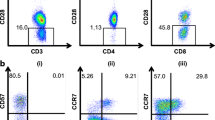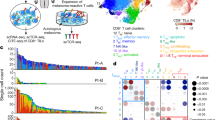Abstract
The immune attack against malignant tumors require the concerted action of CD8+ cytotoxic T lymphocytes (CTL) as well as CD4+ T helper cells. The contribution of T cell receptor (TCR) αβ+ CD4− CD8− double-negative (DN) T cells to anti-tumor immune responses is widely unknown. In previous studies, we have demonstrated that DN T cells with a broad TCR repertoire are present in humans in the peripheral blood and the lymph nodes of healthy individuals. Here, we characterize a human DN T cell clone (T4H2) recognizing an HLA-A2-restricted melanoma-associated antigenic gp100-peptide isolated from the peripheral blood of a melanoma patient. Antigen recognition by the T4H2 DN clone resulted in specific secretion of IFN-γ and TNF. Although lacking the CD8 molecule the gp100-specifc DN T cell clone was able to confer antigen-specific cytotoxicity against gp100-loaded target cells as well as HLA-A2+ gp100 expressing melanoma cells. The cytotoxic capacity was found to be perforin/granzymeB-dependent. Together, these data indicate that functionally active antigen-specific DN T cells recognizing MHC class I-restricted tumor-associated antigen (TAA) may contribute to anti-tumor immunity in vivo.







Similar content being viewed by others
References
Fischer K, Voelkl S, Heymann J, Przybylski GK, Mondal K, Laumer M, Kunz-Schughart L, Schmidt CA, Andreesen R, Mackensen A (2005) Isolation and characterization of human antigen-specific TCR alpha beta+ CD4–CD8- double-negative regulatory T cells. Blood 105:2828–2835
Zinkernagel RM, Doherty PC (1997) The discovery of MHC restriction. Immunol Today 18:14–17
Sprent J, Schaefer M, Lo D, Korngold R (1986) Functions of purified L3T4+ and Lyt-2+ cells in vitro and in vivo. Immunol Rev 91:195–218
Nishimura MI, Avichezer D, Custer MC, Lee CS, Chen C, Parkhurst MR, Diamond RA, Robbins PF, Schwartzentruber DJ, Rosenberg SA (1999) MHC class I-restricted recognition of a melanoma antigen by a human CD4+ tumor infiltrating lymphocyte. Cancer Res 59:6230–6238
Takahama Y, Kosugi A, Singer A (1991) Phenotype, ontogeny, and repertoire of CD4–CD8- T cell receptor alpha beta+ thymocytes. Variable influence of self-antigens on T cell receptor V beta usage. J Immunol 146:1134–1141
Herron LR, Eisenberg RA, Roper E, Kakkanaiah VN, Cohen PL, Kotzin BL (1993) Selection of the T cell receptor repertoire in Lpr mice. J Immunol 151:3450–3459
Landolfi MM, Van Houten N, Russell JQ, Scollay R, Parnes JR, Budd RC (1993) CD2–CD4–CD8- lymph node T lymphocytes in MRL lpr/lpr mice are derived from a CD2+ CD4+ CD8+ thymic precursor. J Immunol 151:1086–1096
Hammond DM, Nagarkatti PS, Gote LR, Seth A, Hassuneh MR, Nagarkatti M (1993) Double-negative T cells from MRL-lpr/lpr mice mediate cytolytic activity when triggered through adhesion molecules and constitutively express perforin gene. J Exp Med 178:2225–2230
Cai Z, Sprent J (1994) Resting and activated T cells display different requirements for CD8 molecules. J Exp Med 179:2005–2015
Young KJ, Kay LS, Phillips MJ, Zhang L (2003) Antitumor activity mediated by double-negative T cells. Cancer Res 63:8014–8021
Ledbetter JA, Seaman WE, Tsu TT, Herzenberg LA (1981) Lyt-2 and lyt-3 antigens are on two different polypeptide subunits linked by disulfide bonds. Relationship of subunits to T cell cytolytic activity. J Exp Med 153:1503–1516
Newberg MH, Ridge JP, Vining DR, Salter RD, Engelhard VH (1992) Species specificity in the interaction of CD8 with the alpha 3 domain of MHC class I molecules. J Immunol 149:136–142
Wedemeyer H, He XS, Nascimbeni M, Davis AR, Greenberg HB, Hoofnagle JH, Liang TJ, Alter H, Rehermann B (2002) Impaired effector function of hepatitis C virus-specific CD8+ T cells in chronic hepatitis C virus infection. J Immunol 169:3447–3458
Salter RD, Norment AM, Chen BP, Clayberger C, Krensky AM, Littman DR, Parham P (1989) Polymorphism in the alpha 3 domain of HLA-A molecules affects binding to CD8. Nature 338:345–347
Rudd CE, Anderson P, Morimoto C, Streuli M, Schlossman SF (1989) Molecular interactions T-cell subsets and a role of the CD4/CD8:p56lck complex in human T-cell activation. Immunol Rev 111:225–266
Muller D, Pederson K, Murray R, Frelinger JA (1991) A single amino acid substitution in an MHC class I molecule allows heteroclitic recognition by lymphocytic choriomeningitis virus-specific cytotoxic T lymphocytes. J Immunol 147:1392–1397
Garcia KC, Scott CA, Brunmark A, Carbone FR, Peterson PA, Wilson IA, Teyton L (1996) CD8 enhances formation of stable T-cell receptor/MHC class I molecule complexes. Nature 384:577–581
Daniels MA, Jameson SC (2000) Critical role for CD8 in T cell receptor binding and activation by peptide/major histocompatibility complex multimers. J Exp Med 191:335–346
Mackensen A, Carcelain G, Viel S, Raynal MC, Michalaki H, Triebel F, Bosq J, Hercend T (1994) Direct evidence to support the immunosurveillance concept in a human regressive melanoma. J Clin Invest 93:1397–1402
Meidenbauer N, Zippelius A, Pittet MJ, Laumer M, Vogl S, Heymann J, Rehli M, Seliger B, Schwarz S, Le Gal FA, Dietrich PY, Andreesen R, Romero P, Mackensen A (2004) High frequency of functionally active Melan-a-specific T cells in a patient with progressive immunoproteasome-deficient melanoma. Cancer Res 64:6319–6326
Salter RD, Howell DN, Cresswell P (1985) Genes regulating HLA class I antigen expression in T–B lymphoblast hybrids. Immunogenetics 21:235–246
Meidenbauer N, Marienhagen J, Laumer M, Vogl S, Heymann J, Andreesen R, Mackensen A (2003) Survival and tumor localization of adoptively transferred Melan-A-specific T cells in melanoma patients. J Immunol 170:2161–2169
Pannetier C, Even J, Kourilsky P (1995) T-cell repertoire diversity and clonal expansions in normal and clinical samples. Immunol Today 16:176–181
Hendriks J, Xiao Y, Borst J (2003) CD27 promotes survival of activated T cells and complements CD28 in generation and establishment of the effector T cell pool. J Exp Med 198:1369–1380
van Berkel ME, Oosterwegel MA (2006) CD28 and ICOS: similar or separate costimulators of T cells? Immunol Lett 105:115–122
Weinberg AD, Vella AT, Croft M (1998) OX-40: life beyond the effector T cell stage. Semin Immunol 10:471–480
Cheuk AT, Mufti GJ, Guinn BA (2004) Role of 4-1BB:4-1BB ligand in cancer immunotherapy. Cancer Gene Ther 11:215–226
Callender GG, Rosen HR, Roszkowski JJ, Lyons GE, Li M, Moore T, Brasic N, McKee MD, Nishimura MI (2006) Identification of a hepatitis C virus-reactive T cell receptor that does not require CD8 for target cell recognition. Hepatology 43:973–981
van der Veken LT, Hagedoorn RS, van Loenen MM, Willemze R, Falkenburg JH, Heemskerk MH (2006) Alphabeta T-cell receptor engineered gammadelta T cells mediate effective antileukemic reactivity. Cancer Res 66:3331–3337
Zhang ZX, Yang L, Young KJ, DuTemple B, Zhang L (2000) Identification of a previously unknown antigen-specific regulatory T cell and its mechanism of suppression. Nat Med 6:782–789
Zhang ZX, Ma Y, Wang H, Arp J, Jiang J, Huang X, He KM, Garcia B, Madrenas J, Zhong R (2006) Double-negative T cells, activated by xenoantigen, lyse autologous B and T cells using a perforin/granzyme-dependent, Fas–Fas ligand-independent pathway. J Immunol 177:6920–6929
Ma Y, He KM, Garcia B, Min W, Jevnikar A, Zhang ZX (2008) Adoptive transfer of double negative T regulatory cells induces B-cell death in vivo and alters rejection pattern of rat-to-mouse heart transplantation. Xenotransplantation 15:56–63
Roszkowski JJ, Lyons GE, Kast WM, Yee C, Van Besien K, Nishimura MI (2005) Simultaneous generation of CD8+ and CD4+ melanoma-reactive T cells by retroviral-mediated transfer of a single T-cell receptor. Cancer Res 65:1570–1576
Clay TM, Custer MC, Sachs J, Hwu P, Rosenberg SA, Nishimura MI (1999) Efficient transfer of a tumor antigen-reactive TCR to human peripheral blood lymphocytes confers anti-tumor reactivity. J Immunol 163:507–513
Cole DJ, Weil DP, Shilyansky J, Custer M, Kawakami Y, Rosenberg SA, Nishimura MI (1995) Characterization of the functional specificity of a cloned T-cell receptor heterodimer recognizing the MART-1 melanoma antigen. Cancer Res 55:748–752
Lyons GE, Moore T, Brasic N, Li M, Roszkowski JJ, Nishimura MI (2006) Influence of human CD8 on antigen recognition by T-cell receptor-transduced cells. Cancer Res 66:11455–11461
Kuball J, Schmitz FW, Voss RH, Ferreira EA, Engel R, Guillaume P, Strand S, Romero P, Huber C, Sherman LA, Theobald M (2005) Cooperation of human tumor-reactive CD4+ and CD8+ T cells after redirection of their specificity by a high-affinity p53A2.1-specific TCR. Immunity 22:117–129
Urdahl KB, Sun JC, Bevan MJ (2002) Positive selection of MHC class Ib-restricted CD8(+) T cells on hematopoietic cells. Nature Immunol 3:772–779
Van Laethem F, Sarafova SD, Park JH, Tai X, Pobezinsky L, Guinter TI, Adoro S, Adams A, Sharrow SO, Feigenbaum L, Singer A (2007) Deletion of CD4 and CD8 coreceptors permits generation of alphabetaT cells that recognize antigens independently of the MHC. Immunity 27:735–750
Landolfi MM, van Houten N, Russell JQ, Scollay R, Parnes JR, Budd RC (1993) CD2–CD4–CD8- lymph node T lymphocytes in MRL lpr/lpr mice are derived from a CD2+ CD4+ CD8+ thymic precursor. J Immunol 151:186–1096
Wadsworth S, Yui K, Siegel RM, Tenenholz DE, Hirsch JA, Greene MI (1990) Origin and selection of peripheral CD4–CD8- T cells bearing alpha/beta T cell antigen receptors in autoimmune gld mice. Eur J Immunol 20:723–730
Bristeau-Leprince A, Mateo V, Lim A, Maqerus-Chatinet A, Solary E, Fischer A, Rieuy-Laucat F, Gouqeon ML (2008) Human TCR alpha/beta+ CD4–CD8- double-negative T cells in patients with autoimmune lymphoproliferative syndrome express restricted Vbeta TCR diversity and are clonally related to CD8+ T cells. J Immunol 181:440–842
Ford MS, Zhang ZX, Chen W, Zhang L (2006) Double-negative T regulatory cells can develop outside the thymus and do not mature from CD8+ T cell precursors. J Immunol 177:2803–2809
Buhlmann JE, Elkin SK, Sharpe AH (2003) A role for the B7-1/B7-2:CD28/CTLA-4 pathway during negative selection. J Immunol 170:5421–5428
Gao JX, Zhang H, Bai XF, Wen J, Zheng X, Liu J, Zheng P, Liu Y (2002) Perinatal blockade of b7-1 and b7-2 inhibits clonal deletion of highly pathogenic autoreactive T cells. J Exp Med 195:959–971
Acknowledgments
We are grateful to the patient who took part in this study. We thank Jana Berger for excellent technical assistance. The authors have no conflicting financial interests.
Author information
Authors and Affiliations
Corresponding author
Additional information
A. Mackensen and K. Fischer contributed equally to this work and should be considered joint senior authors. This work was supported by the Deutsche Forschungsgemeinschaft (MA 1351/5-1, KFO 146) and NIH grants CA90873, CA102280, 104947 (MIN).
Companion paper: “Relationship between CD8-dependent antigen recognition, T cell functional avidity, and tumor cell recognition” by Tamson V. Moore et al. doi: 10.1007/s00262-008-0594-2.
Rights and permissions
About this article
Cite this article
Voelkl, S., Moore, T.V., Rehli, M. et al. Characterization of MHC class-I restricted TCRαβ+ CD4− CD8− double negative T cells recognizing the gp100 antigen from a melanoma patient after gp100 vaccination. Cancer Immunol Immunother 58, 709–718 (2009). https://doi.org/10.1007/s00262-008-0593-3
Received:
Accepted:
Published:
Issue Date:
DOI: https://doi.org/10.1007/s00262-008-0593-3




